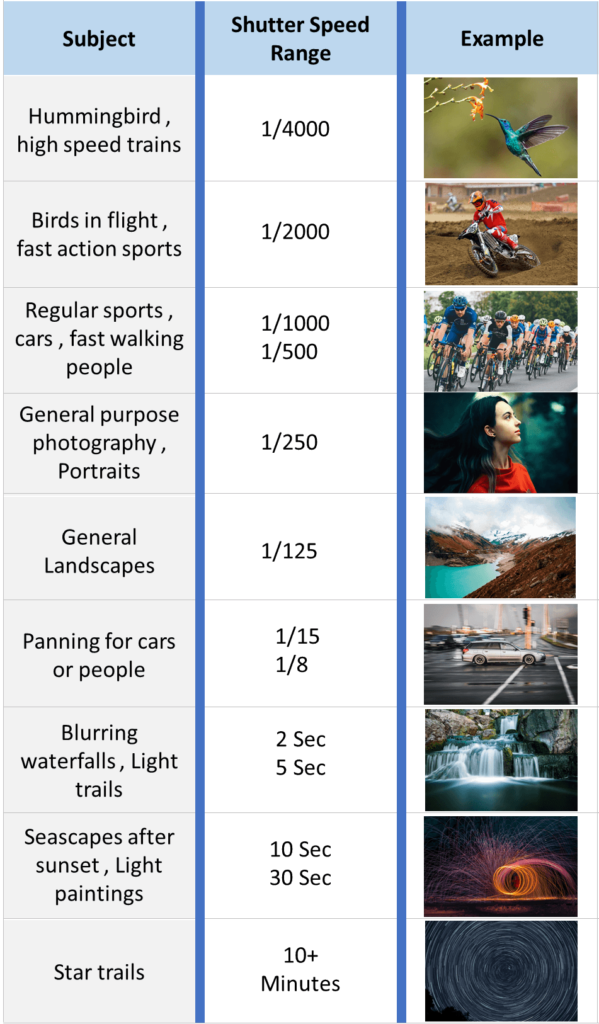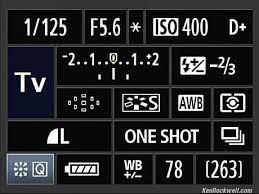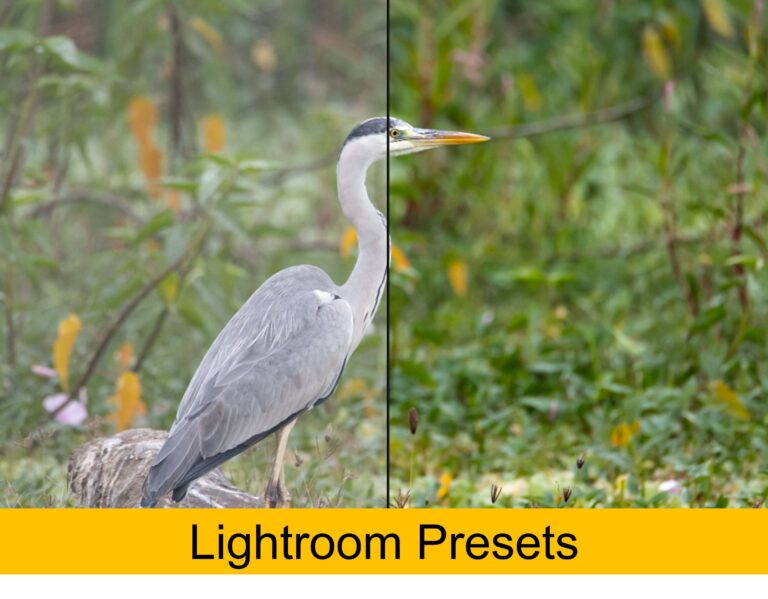Shutter speed is one of the most important setting in photography. The other two are aperture and ISO. Shutter speed chart provides a guide in terms of when and how to use different shutter speed values.
The shutter speed can be used by the camera to adjust the amount of light captured. You can use fast or slow shutter speeds to create creative effects like motion blur or freezing the action.
Shutter speed is the speed of operation of a mechanical component within the camera called shutter. You can refer to various parts of a DSLR camera in this post here.
The shutter is a curtain on a DSLR camera. This curtain, stays closed while the photographer views the scene through an eyepiece. The shutter button is what the photographer presses to capture the scene.
The shutter opens when the shutter button is pressed down. This allows light from the lens to pass through the shutter to the camera sensor. The shutter will close again once the light has been collected. Shutter speed is the time the shutter is open while the sensor is exposed.
In this post we will see in depth about shutter speed for photography , if you wish to learn about shutter speed for video then you can read our article on this topic here.
What is a Shutter speed chart ?
The main purpose of the shutter speed chart is to guide the user to select the appropriate shutter speed for the given situation and lighting conditions.
Different photography situations require different shutter speeds , some require very fast some very slow. The shutter speed chart helps to understand which shutter speed suits witch situation.
Before we get into the shutter speed chart , Lets see what is shutter speed and when to use which shutter speed to get great photos.
Fast and Slow shutter speed
Shutter speed is measured in terms of time. Fast shutter speed means the shutter was open for small amount of time. In other word the shutter opened and closed back again quickly. This means that sensor had very little time to capture the light or scene in front.
Slow shutter speed means the shutter was open for a relatively long time. It means more time was available for sensor to capture the light or the scene in front of the camera.
Fast or slow shutter speeds are relative terms . Shutter speeds are measured as a fraction of second or in seconds. In general fast shutter speed can be anything less than 1/50th of a second and slow shutter speed can be anything more than a second. This again depends on the scene that you are trying to capture.
Shutter speed is said to be slow when it is not adequate to capture action happening in front of the camera without any motion blur.
Fast shutter speeds are generally used for bird photography and wildlife photography.
Shutter speed examples
Cameras differ in the range of available shutter speeds. A typical range starts at 30 sec and ends at 1/4000 sec. As with aperture, the difference between adjacent shutter speeds is known as a stop. Each stop represents a halving of the light reaching the sensor as the shutter speed is made faster (the shutter is open for less time), or a doubling of the amount of light as the shutter speed is made slower (the shutter is open longer)

Shutter speed calaulator
The shutter speed calculator will help you calculate the correct shutter speed to use under all lighting conditions, exposure value, aperture and ISO settings.
How to calculate shutter speed
The formula that calculates the exposure value can be used to calculate shutter speed. After rearranging the variables and using the logarithmic property of the exposure , the following formula can be obtained:
Shutter speed = 100 * aperture2 / (ISO * 2EV)
where:
- shutter speed – Shutter speed in seconds;
- aperture – f-number of the aperture, like 2.8 for f/2.8;
- ISO – ISO sensitivity, as in 100, 200, 400, and so on; and
- EV – Exposure value.
This formula calculates the shutter speed that is required to meet the exposure value of the chosen aperture and ISO settings.
You can read a lot more about this in an article here.
Shutter Speed Chart Canon or Nikon: Guide to using the right shutter speed
The main purpose of the below shutter speed chart is to guide the user to select the appropriate shutter speed for the purpose.
Different photography situations require different shutter speeds , some require very fast some very slow. The shutter speed chart helps to understand which shutter speed suits witch situation.
F stop shutter speed chart
Below shutter speed chart shows the full stop change in shutter speed. If you go from right to left the amount of light increases by one stop for same aperture and ISO. If you go from left to right the amount of light captured by sensor reduces by 1 stop for same ISO and aperture.

Half and 1/3 stop shutter speed chart
In some cases cameras have even finer control on shutter speed . Most cameras these days offer half or even 1/3 stop of variation in shutter speed. Below shutter speed chart gives the half or 1/3 stop values for shutter speeds.

The first column in above shutter speed chart gives us change in light by 1 full stop. This means if you go from 1/8000 to 1/4000 shutter speed you will lose 1 stop of light.
The second column gives us change in light by half stop. This means if you go from 1/8000 to 1/6000 to 1/4000 then you will keep losing half stop of light for every step.
The last column gives us 1/3 stop of light. Thus if you go from 1/8000 to 1/6400 to 1/5000 you will keep losing 1/3 stop of light for every step.
Shutter Speed Chart in seconds : Infographic / cheat sheet
This shutter speed chart infographic or cheat sheet is designed to help you understand what shutter speed values to select for which purpose.
Starting from high speed action photography all the way to long exposure, light trail photography , the chart covers all the aspects.
Shutter speed range from 1/4000 sec to 10+ minutes is used in photography for capturing the essence of various scenes.

How to change the shutter speed
You can achieve stunning results by controlling your shutter speed, as you’ll see from the examples and use cases. How do you adjust your shutter speed?
The shutter speed can be set in the following modes: Manual mode, Shutter Priority Mode (known by “Tv” and “S” respectively for Canon and Nikon), or Bulb mode.
- Shutter priority mode : You can set a shutter speed up to 30 seconds. Camera automatically controls the aperture to achieve the correct exposure at the shutter speed. It is usually labeled “Tv” for Canon cameras and “S” for Nikon cameras.
- Manual mode : You can set a shutter speed up to 30 seconds. To get the best exposure at the shutter speed, you must manually adjust the aperture.
- Bulb Mode : This allows you to set any shutter speed, even longer than 30 seconds. This is especially useful when you need to take pictures with long exposure times.
How to read shutter speed and adjust as per shutter speed chart
The shutter speed can be adjusted accurately in one of the three modes discussed above. In all other camera modes the camera automatically selects the shutter speed and you do not have much control on that.
Once you have selected the right camera mode, you can set the shutter speed on the LCD panel or using one of the dials on the camera. Both achieve the same result and you will see the final value in the LCD panel.

This screenshot of the camera menu shows camera in Tv ( shutter priority) mode and the shutter speed value at 1/125. Using the camera dial you can change this 1/125 shutter speed value to either a slower or faster value.
ISO Aperture and Shutter Speed Chart
One more chart that is widely referred is the ISO aperture and shutter speed chart. This gives an overall idea about the exposure triangle in a chart format.

Summary
Shutter speed is a powerful tool for photographers. You can use the shutter speed chart and cheat sheet to identify the right shutter speed for the scene that you are trying to capture.
However one must learn to set the right shutter speed looking at the scene and that can come only by experience. More photographs you click , better photographer you become.
ISO aperture and shutter speed chart provides and overall view of the entire exposure triangle in a chart format.



